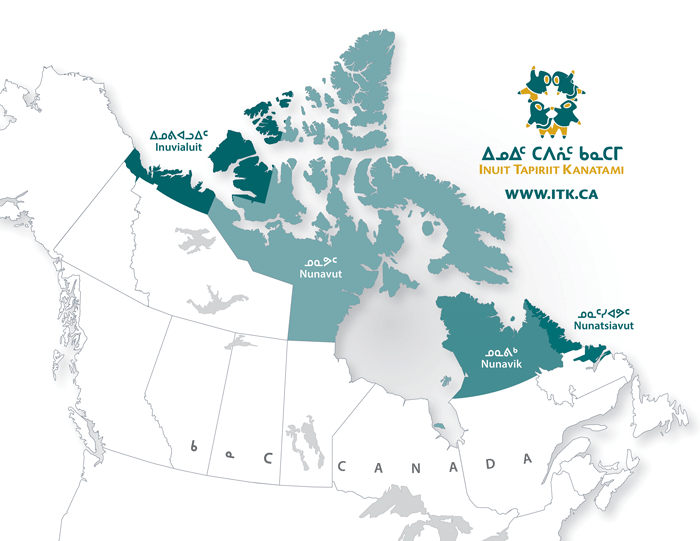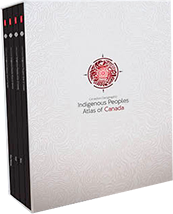Inuit Nunangat
For 5,000 years, the people and culture known throughout the world as “Inuit” have occupied the vast territory stretching from the shores of the Chukotka Peninsula of Russia, east across Alaska and Canada, to the southeastern coast of Greenland. It is here, based on our ability to use the physical environment and living resources of this geographic region known as the Arctic, where our culture developed and our history unfolded.
Inuit are an original people of much of the land now known as Canada, and our history represents an important and fascinating story. It is not just a story about an early chapter of Canadian history. Indeed, it is an epic tale in the history of human settlement and the endurance of culture. Each chapter of our story provides valuable lessons and insights about issues that matter to cultures everywhere. Our history is about people and their relationship to the environment and to each other; about adapting to change as well as the causes and consequences of change forced upon us through colonialism; and about how we are working towards re-establishing control over our cultural, economic and political destiny through land claims and self-government. Above all, the story of Inuit is about how we as a culture are able to live in balance with the natural world.
This is a story that we must begin to tell for ourselves. Unfortunately until now, most of the research on our culture and history has been done by individuals who come from outside our culture. Since the information that these individuals collected was seldom made available to us, the image held by much of the outside world about who we are is usually someone else’s creation, not ours. It will take time to change this situation and we, as Inuit, are certainly prepared to work cooperatively with those who have devoted their professional lives to studying our culture in meaningful and respectful ways. In the meantime, we will reinterpret the information gathered by others to help us speak about ourselves.
Although there are still many important questions to be answered, the available evidence tells us that within the vast geographic regions of the Arctic, our distant and more recent ancestors carved out a homeland and established a way of life that has retained a cultural identity, social coherence and territorial integrity throughout each and every stage of our history. It is true to say that no other living culture has maintained such a continuous and consistent way of life for such a long period of time over such a large territory.
This is a story that we must begin to tell for ourselves.
When we speak about the origins and history of our culture, we do so from a perspective that is different from that often used by non-Inuit who have studied our past. For example, in our culture we do not divide the past from the present, so we do not like to use terms such as “prehistory.” Our history is simply our history, and our oral histories stretch back to time immemorial. We feel that the time has come for us, as Inuit, to take more control over determining what is important and how it should be interpreted. To be of value, our history must be used to instruct our young and to inform all of us about who we are as Inuit in today’s world. We do not want our history to confine us to the past.
Our past is preserved and explained through the telling of stories and the passing of information from one generation to the next through what is called the Oral Tradition. Inuit recognize the importance of maintaining the Oral Tradition as a part of our culture and way of learning. At the same time, we realize that there are other ways to understand the past through activities such as archeology and the study of historical documents. Both ways of knowing must now be used by Inuit, and it is our Elders and our schools that will provide the necessary tools.
Archeology has been one of the important ways for discovering our past. Every summer, archeologists from down south come to our Land. Inuit often travel with them, giving advice about where to go and answering questions about what they find. Now, across our Lands, archeologists are joined in their work by young Inuit who will someday take over their research. Our challenge is to rebuild an understanding of our past by using all of the information we have from our legends, our lived experiences, our knowledge about the Arctic and Subarctic environments and its wildlife, and information now available to us through archeology.

Today, four regions make up Inuit Nunangat: the Inuvialuit Settlement Region (northern Northwest Territories), Nunavut, Nunavik (northern Quebec) and Nunatsiavut (northern Labrador). It includes 53 communities and encompasses roughly 35 per cent of Canada’s land mass and 50 per cent of its coastline. The majority of the 65,000 Inuit in Canada live in Inuit Nunangat, with one-quarter of our population living outside its borders. Of those living outside Inuit Nunangat, about half live in towns or cities. Inuit co-manage our homelands with the federal, provincial and territorial governments through our constitutionally protected land claims agreements. More than a third of the 53 communities in Inuit Nunangat have populations under 500 people and most can only be reached by air year-round and by air and sea during the summer. Our population is very young and one of the fastest-growing in the country.
Canadian Inuit are the largest non-Crown landowners in Canada. Our land claims agreements are living documents that are implemented in a spirit of reconciliation and partnership, are protected by the Constitution and hold interpretive primacy over conflicting federal, provincial or territorial laws. Today’s constitutionally protected co-management partnerships came into existence as a product of the Inuit land claim movement in the 1970s and define Inuit participation in resource management decision-making. We have an official role to play in the way environmental assessment, land and water management, and resource development take place in Canada. It is important to remember that shipping routes through the Northwest Passage pass through Inuit Nunangat.
The governance structure of each of our four regions is outlined in constitutionally-protected land claims agreements. We have extensive surface, subsurface, onshore and offshore rights in the North, and with these rights we hold complex decision-making roles and responsibilities in the management of our lands and waters.
We are a circumpolar people, numbering approximately 160,000 Inuit spread across Chukotka (Russia), Alaska, Canada and Greenland. The Inuit Circumpolar Council (ICC) holds consultative status at the United Nations and provides international representation of our circumpolar Inuit homelands. Inuit own or have jurisdiction over half the Arctic; we are the largest Indigenous landholders in the world.

Order now
from Amazon.ca or Chapters.Indigo.ca or contact your favourite bookseller or educational wholesaler




